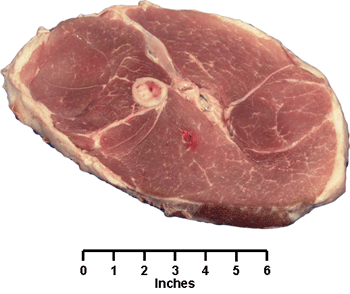Swine Discovery: Retail Cuts
Swine Discovery: Retail Cuts
Cuts Taken from the Jowl
- Large, smoked cut from the jowl (lower neck) area.
- Contains no bone.
- Very wasty cut of meat with lots of fat.
*Cookery Method = Moist
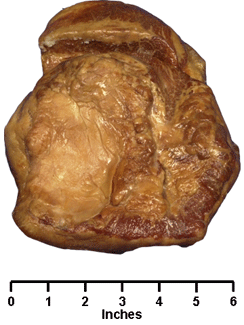
Cuts Taken from the Boston Butt
- Large cut (more than 2 inches thick) from the upper part of the shoulder.
- Contains blade bone exposed on two sides of the cut.
- Contains many different muscles visible on the cut sides.
- Has some fat and connective tissue separating the muscles, as well as some fat on the outside edges.
*Cookery Method = Dry or Moist
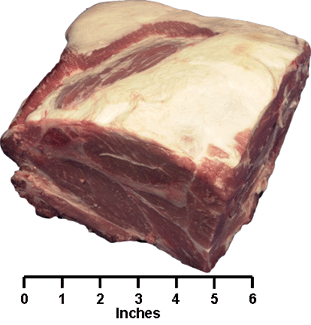
Cuts Taken from the Picnic Shoulder
- Very large cut from the lower part of the shoulder.
- Forearm protrudes at an angle on one side.
- Contains blade bone and round arm bone.
- Contains many different muscles visible on the cut sides.
- Has lots of fat and connective tissue separating the muscles, and considerable fat on the outside edges.
- The shank and a portion of the shoulder are covered with skin
*Cookery Method = Dry or Moist
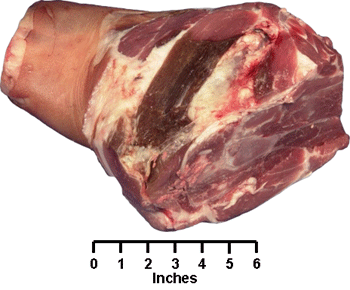
- Large cut, more than 2 inches thick, from the lower part of the shoulder (similar to Pork Shoulder Arm Picnic Roast, except the shank has been removed).
- Cohntains round arm bone visible on each end.
- Contains many different muscles visible on the cut sides.
- Has some fat and connective tissue separating the muscles, and some fat on the outside edges.
*Cookery Method = Dry or Moist
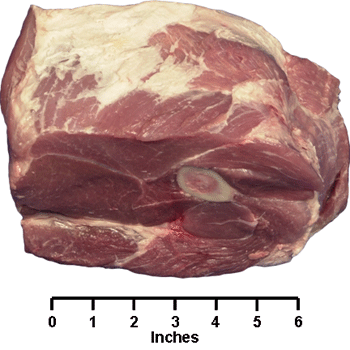
- Steak taken from the Port Shoulder Arm Roast and cut less than 2 inches thick (usually about 3/4 inch thick).
- Contains round arm bone visible on each side.
- Contains many different muscles visible on the cut sides.
- Has some fat and connective tissue separating the muscles, and some fat on the outside edges.
*Cookery Method = Dry or Moist
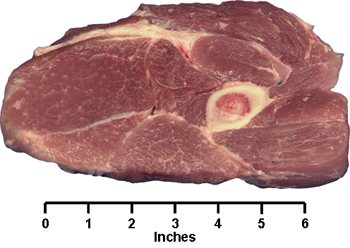
Cuts Taken from the Loin
- Roast (more than 2 inches thick) taken from the part of the rib cage nearest the shoulder.
- Contains blade bone, rib bones, and vertebrae.
- Contains the loin muscle which is surrounded by several smaller muscles.
- Has some fat and connective tissue separating the muscles, and some fat on the outside.
*Cookery Method = Dry or Moist
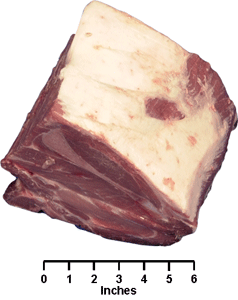
- Chop taken from the blade end of the Loin and cut less than 2 inches thick (usually about 3/4 inch thick).
- Contains parts of the blade bone, rib bone, and vertebrae.
- Contains the loin muscle and several smaller muscles.
- Has some fat and connective tissue separating the muscles, and some fat on the outside.
*Cookery Method = Dry or Moist
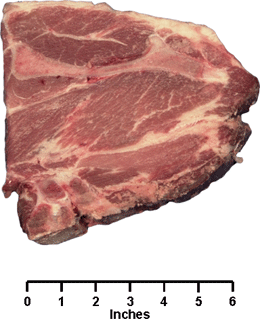
- Roast (more than 2 inches thick) taken from the center rib section of the Loin.
- Contains vertebrae and rib bones.
- Contains the loin muscle as the primary muscle, and some smaller muscles also visible in cut ends.
- Has come fat and a little connective tissue separating the muscles, and some fat on the outside.
*Cookery Method = Dry
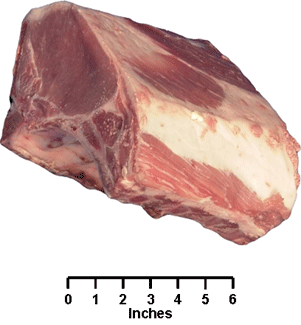
- Chop taken from the rib cage and cut the thickness of one rib bone (usually about 3/4 inch thick).
- Contains vertebrae and rib bone.
- Loin muscle is the primary muscle, and several smaler muscles may also be present.
- Has some fat and a little connective tissue separating the muscles, and some fat on the outside.
*Cookery Method = Dry
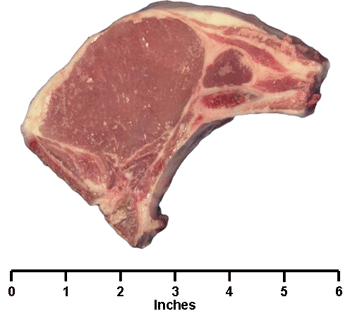
- Roast (more than 2 inches thick) taken from the center of the Loin (past the last rib).
- Contains vertebrae ("T" bones) and possibly one rib bone on the rib end.
- Contains the loin muscle as the primary muscle on the rib side, and the large loin muscle and smaller tenderloin muscle on the loin side. Several smaller muscles also visible in cut ends.
- Has some fat and a little connective tissue seperating the muscles, and some fat on the outside.
*Cookery Method = Dry
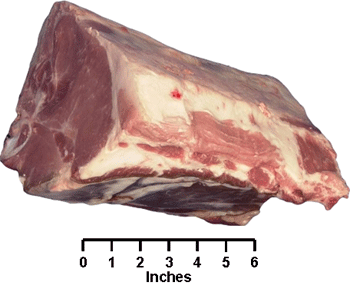
- Chop taken fromt he sirloin have of the Loin and usually cut less than 1 inch thick.
- Contains vertebrae ("T" bone).
- Contains the large loin muscle and the smaller tenderloin muscle (separated by the "T" bone).
- Has some fat and connective tissue separating the muscles, and some fat on the outside edges.
*Cookery Method = Dry
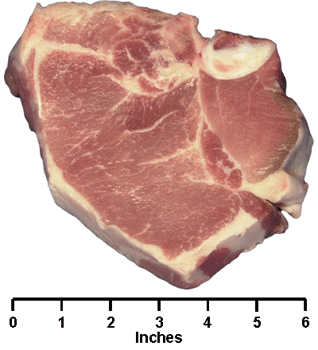
- Chop taken from the sirloin half of the Loin and usually cut less than 1 inch thick. (similar to Pork Loin Chop, except tenderloin muscle and part of chine has been removed).
- Contains vertebrae on top and one side.
- Contains the large loin muscle as the primary muscle (some smaller muscles also present).
- Has some fat and connective tissue separating the muscles, some marbling, and some fat on the outside edges.
*Cookery Method = Dry
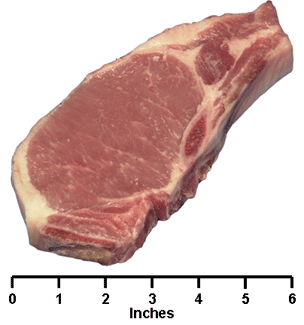
- Chop made from an extra thick (about 2 inches) Pork Loin Top Loin Chop. It is cut down the center and opened flat, and results in a 1 inch thick chop. Resembles a butterfly in appearance.
- Contains no bone.
- Contains one muscle (the loin muscle).
- Has some marbling, and some fat on the outside edges.
*Cookery Method = Dry
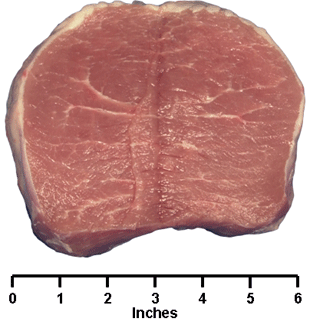
- Chop taken from the sirloin end of the Loin (nearest the Ham) that is usually less than 1 inch thick.
- Contains part of hip bone and vertebrae ("T" bone).
- Contains loin muscle, tenderloin muscle, and some other small muscles.
- Has some fat and connective tissue separating the muscles, some marbling, and some fat on the outside edges.
*Cookery Method = Dry
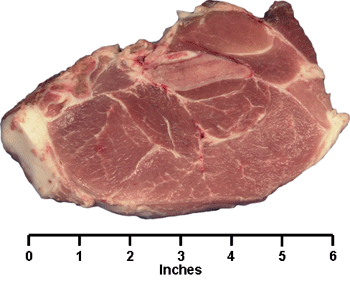
- Smoked and cured cut taken from the Loin.
- Contains no bone.
- Contains only the loin muscle.
- Has some fat on the outside edges.
*Cookery Method = Dry
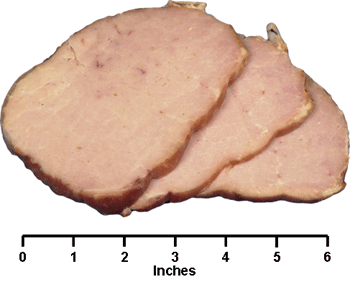
- Cured and smoked chop taken from the rib cage and cut the thickness of one rib bone (usually about 3/4 inch thick).
- Contains vertebrae and rib bone.
- Loin muscle is the primary muscle, and some other smaller muscles may also be present.
- Has some fat and a little connective tissue separating the muscles, and some fat on the outside.
*Cookery Method = Dry
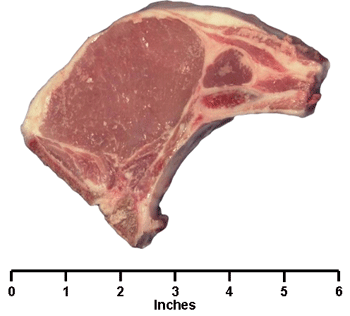
Cuts Taken from the Belly (Bacon)
- Cut taken from the Belly. The portion that remains after the Loin and Spareribs have been removed.
- Contains no bone.
- Contains several grainy muscles.
- Has fat and some connective tissue separating the muscles, and considerable fat on the outside.
*Cookery Method = Dry or Moist
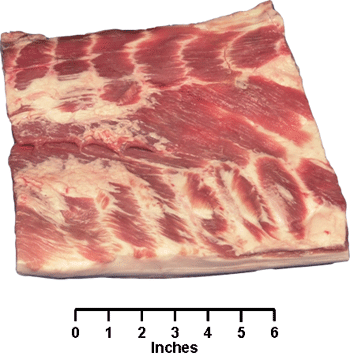
- Cut taken fromt he Fresh Port Side. Usually sliced 1/8 inch or less.
- Contains no bone.
- Contains several grainy muscles.
- Has considerable fat separating the muscles and on the outside.
*Cookery Method = Dry
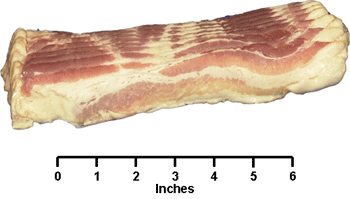
- Cut taken from the Belly. May be fresh pork or cured and smoked.
- Contains portions of th erib bones.
- Contains several grainy muscles.
- Has some fat and connective tissue separating the muscles, and some fat on the outside.
*Cookery Method = Dry or Moist
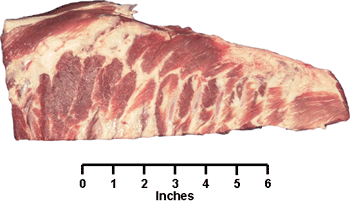
Cuts Taken from the Ham
- Large cut taken from the sirloin end (upper area) of the Ham.
- Contains pelvic bone and part of round leg bone.
- Contains several large muscles.
- Has some fat and connective tissue separasting the muscles, and some fat on the outside.
*Cookery Method = Dry or Moist
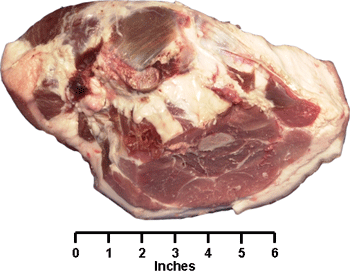
- Large cut taken from the lower half of the Ham. It tapers in size from the butt face to the hock.
- Contains round leg bone.
- Contains several large muscles.
- Has some fat and connective tissue separating the muscles, and some fat on the outside. The shank end of the cut is covered with skin.
*Cookery Method = Dry or Moist
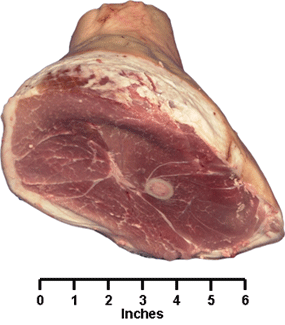
- Cut taken from the center of the Ham.
- Contains round leg bone.
- Contains several large muscles, including the top, bottom, eye, and tip muscles.
- Has some fat and connective tissue separating the muscles, and some fat on the outside edges.
*Cookery Method = Dry or Moist
